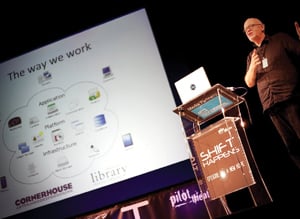Digital intelligence
At the ‘Shift Happens’ conference, Dave Moutrey gave us a glimpse of the digitally enabled organisation of the future

Cornerhouse and the Library Theatre Company have become one legal entity and in 2014 this merged organisation will move into a purpose-built venue. A 500- and a 160-seat flexible theatre, 500 square metres of galleries, five cinema screens, education facilities, café, bar etc. I’m sure you can picture it all and even imagine the smell of the new carpets. Our as yet unnamed building is also being designed from the outset to be ‘digitally enabled’ with a low carbon output, but envisioning this is a bit more challenging. In summary, new organisation + new building + new technology + low carbon = huge challenge. But every challenge is an opportunity in disguise (please excuse the cliché). We therefore have a major opportunity to rethink how we do things and digital technologies will play a major role.
I mention this because I was asked to write about what might be the ‘next big thing’ on the digital horizon, so this project provides the context. The arts sector I believe is no better or worse than most other businesses in the UK when it comes to using digital technologies: some organisations and individuals are early adopters and other laggards. So, suggesting what might be the next big thing will depend on where on the Bell Curve one sits. I have a tendency towards ‘early adopter’ (as I like gadgets) and my Operations Director, Pat, tends towards ‘late majority’ (as Pat wants stuff to work and wants bugs ironed out before we use it). Where we end up will probably be driven by practicalities rather than my fetish for gadgets. It is easy to dismiss what we are doing on the “it’s ok for you as you are getting a new building” basis but actually, if we were not getting a new building, we would be finding ways of doing these things anyway.
Here is a snapshot of our thinking so far:
It never ceases to amaze me how dull and lacking in creativity we manage to make the majority of office spaces in arts organisations. I know that one person’s creative space is another person’s teenage bedroom, but we do need a more flexible approach. Call-centre-style open plan I’m sure is not right but neither is the Google approach of deckchairs and basketball hoops (for us anyway). Finding a space where our finance team can concentrate on making sure everyone gets paid or where our theatre team can work in detail on a script is as important as making space for creative debates about artistic policy or haranguing a newspaper to come and review an exhibition. Whatever happens with the interior, design technology will be part of the solution.
Our ‘digitally enabled’ building will have both an extensive and high capacity wired network of fibre and Cat 6 cable but also ubiquitous wireless broadband. This is leading us to ask questions like “does everyone need a desk with a telephone and desktop PC on it?” (I know we are slow to catch on). Our finance team may do but what would happen if our press office used iPads and IP based smart phones? Would they need a desk? We are also looking seriously at Cloud computing. Our organisation employs over 50 people who regularly work on computers. At present we have a mixed platform of Apple and PC computers each with Microsoft Office plus other software licenced at a huge cost that needs updating every 3–5 years. Moving to Cloud-based applications means lower capital costs, less worries about back-ups and regular updates, and supports remote-working and collaboration much more effectively.
It goes without saying now that our technicians need access to advanced and robust digital networks for sound, lighting, stage automation and video controls in our theatres, galleries, cinemas, public and education spaces. However, we are planning to make our work more available outside of the building using digital technologies. We are building a digital edit suite at the heart of the building to enable us to take live feeds from the remote HD video cameras in our programme spaces, live edit/record and then distribute onto web platforms or directly to other venues. It will be almost unthinkable that a subsidised arts venue will not be able to distribute work in this way in the next 3 to 5 years.
Energy costs and carbon reduction will continue to be an increasingly important issue for arts organisations. Intelligent building management systems will be part of the answer. The increasingly demanding Building Regulations Part L are requiring new buildings to be designed to conserve and consume power and fuel. In addition to insulation, low energy heating systems etc., new buildings will have power/fuel consumption meters and other sensors not just for the whole building but throughout, so it is possible to measure consumption for each theatre, gallery, cinema, office and café on the basis “if you can measure it you can manage it”. Intelligent building systems take this data and use it to control security, lighting, air handling, heaters and other building systems in one integrated place. Until recently they had a poor reputation as many were proprietary, not upgradable or inter-operable and therefore expensive. However, systems using the KNX standard have changed this and we will see more intelligent technology in new buildings and retro-fitted to existing ones.
Like it or not the future is definitely digital.
Join the Discussion
You must be logged in to post a comment.